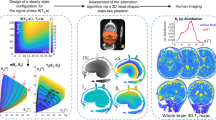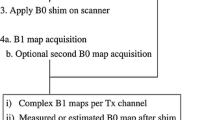Abstract
Objective
The aim of this study is to present a new approach for making quantitative single-voxel T 2 measurements from an arbitrarily shaped region of interest (ROI), where the advantage of the signal-to-noise ratio (SNR) per unit time of the single-voxel approach over conventional imaging approach can be achieved.
Materials and methods
Two-dimensional (2D) spatially selective radiofrequency (RF) pulses are proposed in this work for T 2 measurements based on using interleaved spiral trajectories in excitation k-space (pinwheel excitation pulses), combined with a summed Carr–Purcell Meiboom–Gill (CPMG) echo acquisition. The technique is described and compared to standard multi-echo imaging methods, on a two-compartment water phantom and an excised brain tissue.
Results
The studies show good agreement between imaging and our method. The measured improvement factors of SNR per unit time of our single-voxel approach over imaging approach are close to the predicted values.
Conclusion
Measuring T 2 relaxation times from a selected ROI of arbitrary shape using a single-voxel rather than an imaging approach can increase the SNR per unit time, which is critical for dynamic T 2 or multi-component T 2 measurements.
Similar content being viewed by others
References
Carr HY and Purcell EM (1954). Effects of diffusion on free precession in numclear magnetic resonacne experiments. Phys Rev 94: 630–638
Meiboom S and Gill D (1958). Modified spin echo method for measuring nuclear relaxation times. Rev Sci Intrum 29: 688–691
Does MD and Gore JC (2000). Rapid acquisition transverse relaxometric imaging. J Magn Reson 147(1): 116–120
Oh J, Han ET, Pelletier D and Nelson SJ (2006). Measurement of in vivo multi-component T2 relaxation times for brain tissue using multi-slice T2 prep at 1.5 and 3 T. Magn Reson Imaging 24(1): 33–43
Madler B, Mackay AL (2006) In-vivo 3D T2-relaxation measurements for quantitative myelin imaging. Imaging Myelin: formation, cestruction and repair; Vancouver, Canada, p 72
Granot J (1986). Selected Volume Spectroscopy (SVS) and chemical-shift imaging. A comparison. J Magn Reson 66: 197–200
Graham SJ, Stanchev PL and Bronskill MJ (1996). Criteria for analysis of multicomponent tissue T-2 relaxation data. Magn Reson Med 35(3): 370–378
Singh S, Rutt BK and Henkelman RM (1990). Projection presaturation: a fast and accurate technique of multidimensional spatial localization. J Magn Reson 87: 567–583
Ordidge RJ, Connelly A and Lohman JAB (1986). Image-selected in vivo spectroscopy (ISIS)—a new technique for spatially selective NMR-spectroscopy. J Magn Reson 66(2): 283–294
Frahm J, Merboldt KD and Hanicke W (1987). Localized proton spectroscopy using stimulated echoes. J Magn Reson 72(3): 502–508
Bottomley PA (1987). Spatial localization in NMR-spectroscopy in vivo. Ann N Y Acad Sci 508: 333–348
Saab G, Thompson RT, Marsh GD (1997) A technique for localized multicomponent T 2 measurement in skeletal muscle. In: Proceedings of the international society for magnetic resonance in medicine. Fifth Scientific Meeting and Exhibition, Vancouver, Canada, p 1372
Saab G, Thompson RT and Marsh GD (1999). Multicomponent T 2 relaxation of in vivo skeletal muscle. Magn Reson Med 42: 150–157
Saab G, Thompson RT and Marsh GD (2000). Effects of exercise on muscle transverse relaxation determined by MR imaging and in vivo relaxometry. J Appl Physiol 88: 226–233
Graham SJ and Bronskill MJ (1996). MR measurement of relative water content and multicomponent T-2 relaxation in human breast. Magn Reson Med 35(5): 706–715
Pauly J, Nishimura D and Macovski A (1989). A k-space analysis of small-tip-angle excitation. J Magn Reson 81(1): 43–56
Pauly J, Nishimura D and Macovski A (1989). A linear class of large-tip-angle selective excitation pulses. J Magn Reson 82(3): 571–587
Hardy CJ and Cline HE (1989). Spatial localization in 2 dimensions using NMR designer pulses. J Magn Reson 82(3): 647–654
Hardy CJ and Bottomley PA (1991). P-31 spectroscopic localization using pinwheel NMR excitation pulses. Magn Reson Med 17(2): 315–327
Qin Q, Gore JC, Does MD, Avison MJ and DeGraaf RA (2007). 2D Arbitrary shape selective excitation summed spectroscopy (ASSESS). Magn Reson Med 58(1): 19–26
Bornert P and Aldefeld B (1998). On spatially selective RF excitation and its analogy with spiral MR image acquisition. Magn Reson Mater Phy 7: 166–178
Rahmer J, Bornert P, Groen J and Bos C (2006). Three-dimensional radial ultrashort echo-time imaging with T-2 adapted sampling. Magn Reson Med 55(5): 1075–1082
Mao J, Mareci TH, Scott KN and Andrew ER (1986). Selective inversion radiofrequency pulses by optimal control. J Magn Reson 70: 310–318
Poon CS and Henkelman RM (1992). Practical T 2 quantitation for clinical-applications. J Magn Reson Imag 2(5): 541–553
Whittall KP and Mackay AL (1989). Quantitative interpretation of NMR relaxation data. J Magn Reson 84(1): 134–152
D’Arceuil HE, Westmoreland S and Crespigny AJ (2007). An approach to high resolution diffusion tensor imaging in fixed primate brain. Neuroimage 35(2): 553–565
Author information
Authors and Affiliations
Corresponding author
Rights and permissions
About this article
Cite this article
Qin, Q., Gore, J.C., de Graaf, R.A. et al. Quantitative T 2 measurement of a single voxel with arbitrary shape using pinwheel excitation and CPMG acquisition. Magn Reson Mater Phy 20, 233–240 (2007). https://doi.org/10.1007/s10334-007-0088-9
Received:
Revised:
Accepted:
Published:
Issue Date:
DOI: https://doi.org/10.1007/s10334-007-0088-9




